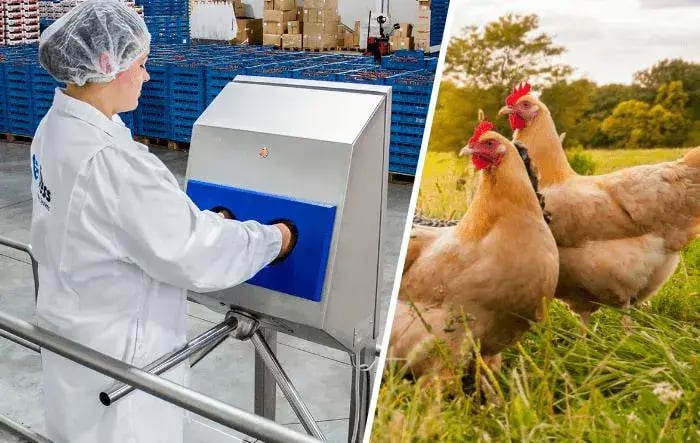Hygiene measures to reduce the risk of bird flu

Bird flu is and remains a continuous threat to the agricultural sector in the Netherlands. The virus can be spread by direct contact between birds, through infected materials and through the air. A high hygiene status on your poultry farm is also highly important.
Infected birds – so also poultry – spread the virus through the airways, ocular fluid and droppings. Also, through dust from infected stalls, the virus can spread through the air. Then the virus can spread through materials, such as feed, crates, means of transport and also through clothing and shoes. Therefore, it is important that poultry farmers are aware of hygiene. Good hygiene management has everything to do with the right mindset.
A CLEAN AND TIDY PLANT
Hygiene management starts with a clean and tidy facility. It is important to ensure that all materials and equipment have a fixed place and that there is no clutter lying around. Keep facility rooms such as the canteen, central hallway and hygienic entrance nice and clean. To do this, ensure that the yard around the shed is always tidy. Keep grass around the shed short, so that pests have less chance and ensure good pest prevention and – when necessary – adequate pest control.
ENTRY INTO THE YARD ONLY WITH PERMISSION
Visitors must park their vehicles on a car park outside the barrier around the facility grounds. Then, it is important that visitors may only enter the facility grounds with your permission. Furthermore, they may not take their ‘own’ materials, equipment and tools into the shed, unless you have also given permission for this, and the materials and equipment are cleaned and disinfected thoroughly first.
ACCESS ONLY THROUGH THE HYGIENE ENTRANCE
All those entering the shed – so yourself and your employees themselves as well as visitors – may only enter the shed through the hygienic entrance. Ensure that this is set up well and efficiently. Preferably they shower there: from 1 July 2028 this is compulsory. Until this time, cleaning and disinfecting hands and boots is also sufficient, and compulsory changing into the facility's own clothing and boots. It is essential that there is a strict separation between the ‘dirty’ area – where the visitor leaves their own clothing and footwear – and the ‘clean’ area where the work clothes and also the compulsory mouth coverings, hair nets and disposable gloves are available. For clothing and boots, follow the rule of thumb: ‘inside is inside and outside is outside’. Also when leaving the shed, clothing is changed again and you preferably shower again.
more information
Elpress is a specialist in the field of personal hygiene. Do you want to know what the options are in this area for your poultry farm? Download our special brochure now.
.webp)



.jpg?width=600&height=300&name=83203100%20-%20DZD-1000-R%20(3.1).jpg)

